Solar Power Potential from Industrial Buildings and Impact on Electricity Supply in Bangladesh
Abstract
:1. Introduction
- (1)
- The rooftop areas of the factory buildings can provide reasonable spaces for installing PV systems, producing green power whilst cutting energy bills and the carbon emissions of the plants.
- (2)
- Scarce land can be saved for farming and other indispensable uses delivering a higher rate of return.
- (3)
- Solar energy can displace imports from the national grid, and excess energy can be fed back into the grid. These twin effects, coupled with net metering, will enhance the nationwide energy availability through a sustainable energy supply.
2. Case for Solar Photovoltaics in Bangladesh
2.1. Solar Energy Potential in Bangladesh
2.2. Rooftop Solar PV in Bangladesh
2.3. Grid Stability
2.4. Net Energy Metering in Bangladesh
3. Methodology
- (a)
- Collecting factories’ data and their geolocations
- (b)
- Selection of representative sample of factories
- (c)
- Estimating roof areas of the factories
- (d)
- Estimating the solar resource for each roof area
- (e)
- Generalising the method to cover all factories
- (f)
- Land displacement
4. Results and Discussions
5. Future Work
6. Conclusions
Author Contributions
Funding
Acknowledgments
Conflicts of Interest
Appendix A
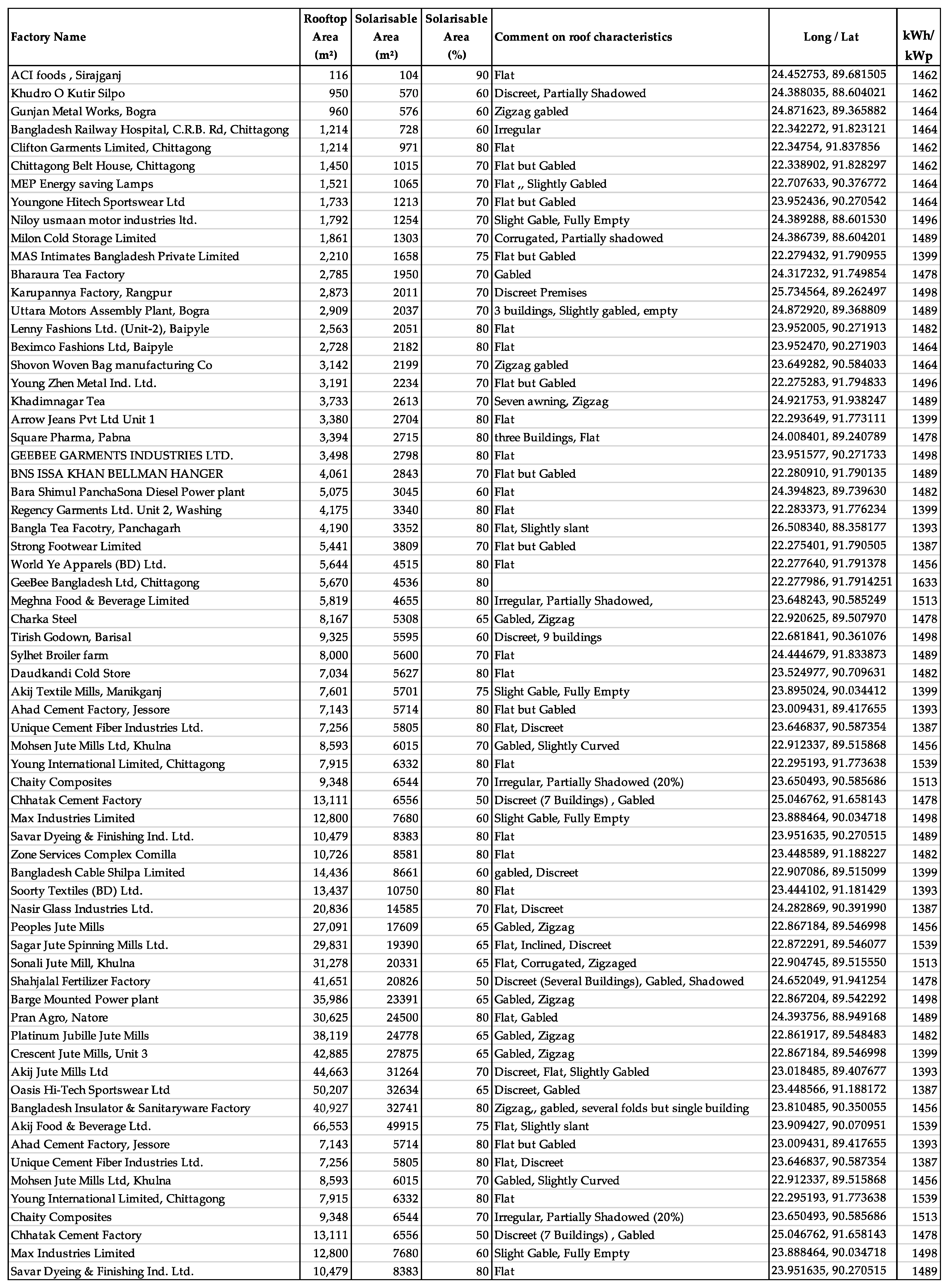
References
- Dey, S.R.; Tareque, M. Electricity consumption and G.D.P. nexus in Bangladesh: A time series investigation. J. Asian Bus. Econ. Stud. 2019, 27, 35–48. [Google Scholar] [CrossRef]
- Taheruzzaman, M.; Janik, P. Electric energy access in Bangladesh. Trans. Environ. Electr. Eng. 2016, 1, 6–17. [Google Scholar] [CrossRef] [Green Version]
- U.N. Achieving Sustainable Energy Targets in Bangladesh. 2020. Available online: https://www.un.org/en/chronicle/article/achieving-sustainable-energy-targets-bangladesh (accessed on 5 November 2021).
- Islam, S. Bangladesh Outlines Plan for up to 40 G.W. of Renewables in 2041. PV Magazine. 20 October 2020. Available online: https://www.pv-magazine.com/2020/10/20/bangladesh-outlines-plan-for-up-to-40-gw-of-renewables-in-2041/ (accessed on 10 November 2021).
- Halder, P.K.; Paul, N.; Joardder, M.U.H.; Sarker, M. Energy scarcity and potential of renewable energy in Bangladesh. Renew. Sustain. Energy Rev. 2015, 51, 1636–1649. [Google Scholar] [CrossRef]
- KhareSaxena, A.; Saxena, S.; Sudhakar, K. Energy performance and loss analysis of 100 kWp grid-connected rooftop solar photovoltaic system. Build. Serv. Eng. Res. Technol. 2021, 42, 485–500. [Google Scholar] [CrossRef]
- Sustainable and Renewable Energy Development Authority (S.R.E.D.A.). Net Metering Guidelines 2018; Sustainable and Renewable Energy Development Authority (S.R.E.D.A.), Power Division, The Government of the People’s Republic of Bangladesh: Dhaka, Bangladesh, 2018; Amended in 2019.
- Nikita, K.N.; Islam, S.N.; Islam, M.S.; Saha, M.; Khan, M.F. Prospect of Solar PV Based Power Generation in the Marshy Lands of Bangladesh: An Analysis through RETScreen Software. In Proceedings of the 2016 4th International Conference on the development in the in Renewable Energy Technology (I.C.D.R.E.T.), Dhaka, Bangladesh, 7–9 January 2016. [Google Scholar]
- Vuković, D. How Much Land Do You Need to Be Self-Sufficient? Primalsurvivor. 7 October 2019. Available online: https://www.primalsurvivor.net/much-land-need-self-sufficient/ (accessed on 13 November 2021).
- Haque, M.N.; Ali, M.H.; Masum, S.M. Climate Change Impacts on Rice Production in Bangladesh; LAP Lambert Academic Publishing: Saarbrücken, Germany, 2016. [Google Scholar]
- Ali, M.A. Settlement of Land Disputes in Bangladesh: Legal Issues and Challenges. Southeast Univ. J. Law 2020, 3, 2020. [Google Scholar]
- World Bank (W.B.). Arable Land (Hectares per Person)—Bangladesh. 2021. Available online: https://data.worldbank.org/indicator/AG.LND.ARBL.HA.PC?locations=BD (accessed on 12 November 2021).
- Bangladesh Bureau of Statistics (B.B.S.). 2021. Available online: http://www.bbs.gov.bd/site/page/47856ad0-7e1c-4aab-bd78-892733bc06eb/Population-&-Housing (accessed on 10 November 2021).
- Energy Bangla. Largest Solar Power Plant Starts Operation in Teknaf. 2018. Available online: https://www.energybangla.com/largest-solar-power-plant-starts-operation-in-teknaf/ (accessed on 10 November 2021).
- I.R.E.N.A. 2021. Available online: https://www.irena.org/costs/Power-Generation-Costs/Solar-Power (accessed on 14 November 2021).
- Rahman, M.M.; Ahmed, A.U.; Dey, P.; Habib, A.; Reza, C.M.F.S.; Aziz, F.; Mamoon, A. Solar Energy Potential in Bangladesh. In Proceedings of the International Conference on Mechanical Engineering and Renewable Energy, Chittagong, Bangladesh, 24–27 December 2013. [Google Scholar]
- Karim, M.E.; Karim, R.; Islam, M.T.; Muhammad-Sukki, F.; Bani, N.A.; Muhtazaruddin, M.N. Renewable Energy for Sustainable Growth and Development: An Evaluation of Law and Policy of Bangladesh. Sustainability 2019, 11, 5774. [Google Scholar] [CrossRef] [Green Version]
- Samad, H.A.; Khandker, S.R.; Asaduzzaman, M.; Yunus, M. The Benefits of Solar Home Systems: An Analysis from Bangladesh (6724); World Bank Group: Washington, DC, USA, 2013. [Google Scholar]
- BanglaPedia. 2021. Available online: https://en.banglapedia.org/index.php/Haors_and_Wetlands (accessed on 3 November 2021).
- Herrera, A. Access to Khas Land in Bangladesh: Discussion on the Opportunities and Challenges for Landless People, and Recommendations for Development Practitioners; NADEL-Center for Development and Cooperation of Master of Advanced Studies Essays: Zurich, Switzerland, 2016. [Google Scholar]
- Sustainable and Renewable Energy Development Authority (S.R.E.D.A.). National Solar Energy Roadmap, 2021–2041 (Draft); Sustainable and Renewable Energy Development Authority (S.R.E.D.A.), Power Division, Ministry of Power, Energy and Mineral Resources, the Government of the People’s Republic of Bangladesh: Dhaka, Bangladesh, 2020. Available online: http://sreda.gov.bd/site/notices/2ee87680-e210-481e-bf40-126ac67949a2/DRAFT---National-Solar-Energy-Roadmap-2021---2041 (accessed on 11 October 2021).
- Sustainable and Renewable Energy Development Authority (S.R.E.D.A.). Statistics of Installed Net Energy Metering System; Sustainable and Renewable Energy Development Authority (S.R.E.D.A.), Power Division, The Government of the People’s Republic of Bangladesh: Dhaka, Bangladesh, 2021. Available online: https://solar.sreda.gov.bd/nem/nemstatistics.php (accessed on 13 November 2021).
- Timmer, J. China’s Solar Power Has Reached Price Parity with Coal, Adding Storage Could Allow Solar to Produce Nearly Half of China’s Electricity. 2021. Available online: https://arstechnica.com/science/2021/10/the-shifting-economics-of-solar-power-in-china/ (accessed on 2 November 2021).
- Chowdhury, S.A.; Khan, M.Z.R. The Net Metering Guideline of Bangladesh-Potential and Way Forward. In Proceedings of the 11th International Conference on Electrical and Computer Engineering (I.C.E.C.E.), Dhaka, Bangladesh, 17–19 December 2020. [Google Scholar]
- Gajduk, A.; Todorovski, M.; Kocarev, L. Stability of power grids: An overview. Eur. Phys. J. Spec. Top. 2014, 223, 2387–2409. [Google Scholar] [CrossRef]
- Lawson, A.J. Net Metering: In Brief. 2019. Available online: https://www.everycrsreport.com/files/20191114_R46010_058b35011000a3009a1ff07a76ca504f00258c98.pdf (accessed on 13 November 2021).
- Dhaka Electric Supply Company Limited (D.E.S.C.O.). 2021. Available online: https://www.desco.org.bd/bangla/descoataglance_e.php (accessed on 13 November 2021).
- Ministtry of Industries. List of Manufacturing Plants; Ministtry of Industries (MoI), The Government of the People’s Republic of Bangladesh: Dhaka, Bangladesh, 2020. Available online: https://moind.gov.bd/ (accessed on 11 October 2021).
- Department of Inspection for Factories and Establishments. D.I.F.E. to Assess Every Industry in Bangladesh; Department of Inspection for Factories and Establishments (D.I.F.E.), Ministry of Labour and Employment: Dhaka, Bangladesh, 2021. Available online: http://dife.gov.bd/site/news/d50e2584-5019-422b-994b (accessed on 10 November 2021).
- Survey Monkey. Survey Monkey Sample Size Calculator. 2021. Available online: https://www.surveymonkey.co.uk/mp/sample-size-calculator/ (accessed on 13 November 2021).
- López, F.; Inmaculada LGonzález-Aguilera, D. Large Scale Automatic Analysis and Classification of Roof Surfaces for the Installation of Solar Panels Using a Multi-Sensor Aerial Platform. Remote Sens. 2015, 7, 1226. [Google Scholar] [CrossRef] [Green Version]
- Nazmul, R.B. Calculating Optimum Angle for Solar Panels of Dhaka, Bangladesh for Capturing Maximum Irradiation. In Proceedings of the 2017 IEEE International W.I.E. Conference on Electrical and Computer Engineering (WIECON-ECE), W.I.T., Dehradun, India, 18–19 December 2017. [Google Scholar]
- Niranjan, S.B.; Nikhil, C. Performance comparison of mono and polycrystalline silicon solar photovoltaic modules under tropical wet and dry climatic conditions in east-central India. Clean Energy 2022, 6, 929–941. [Google Scholar] [CrossRef]
- University of Southampton (UoS). Energy Access. 2020. Available online: https://energy.soton.ac.uk/energy-access/ (accessed on 20 April 2022).
- Rensmart. Carbon Emissions Calculator. 2021. Available online: https://www.rensmart.com/Calculators/KWH-to-CO2 (accessed on 15 January 2022).
- S.R.E.D.A. 2022. Available online: https://solar.sreda.gov.bd/doc/Brochure%20on%20Net%20Metering%20Rooftop%20Solar.pdf (accessed on 15 January 2022).
- World Bank. Lighting Up Rural Communities in Bangladesh: The Second Rural Electrification and Renewable Energy Development Project. 2021. Available online: https://documents.worldbank.org/pt/publication/documents-reports/documentdetail/767471568288649844/bangladesh-second-rural-electrification-and-renewable-energy-development-project-lighting-up-rural-communities (accessed on 21 November 2021).
- Ekushe. Mehdi Hasan Albakar. 2020. Available online: https://www.ekushey-tv.com/%E0%A6%AC%E0%A6%BE%E0%A7%9C%E0%A6%9B%E0%A7%87-%E0%A6%A8%E0%A7%87%E0%A6%9F-%E0%A6%AE%E0%A6%BF%E0%A6%9F%E0%A6%BE%E0%A6%B0%E0%A6%BF%E0%A6%82-%E0%A6%B0%E0%A7%81%E0%A6%AB%E0%A6%9F%E0%A6%AA-%E0%A6%B8%E0%A7%8B%E0%A6%B2%E0%A6%BE%E0%A6%B0-%E0%A6%8F%E0%A6%A8%E0%A6%BE%E0%A6%B0%E0%A7%8D%E0%A6%9C%E0%A6%BF-%E0%A6%AC%E0%A7%8D%E0%A6%AF%E0%A6%AC%E0%A6%B9%E0%A6%BE%E0%A6%B0%E0%A6%95%E0%A6%BE%E0%A6%B0%E0%A7%80/94778 (accessed on 10 November 2021).
- Amin, S.; Jamasb, T.; Llorca MMarsiliani, L. The role of captive power plants in the bangladesh electricity sector. In A.D.B.I. Working Paper Series; Asian Development Bank Institute (A.D.B.I.): Tokyo, Japan, 2021. [Google Scholar]
- Power Grid Company of Bangladesh. Transmission Infrastructure Information; Power Grid Company of Bangladesh (P.G.C.B.), Bangladesh Power Development Board (B.P.D.B.), Power Division, Bangladesh: Dhaka, Bangladesh, 2021. Available online: http://pgcb.gov.bd/site/page/05a258ae-2288-44d5-95c1-4e30b35eb7ec/- (accessed on 21 November 2021).
- Ruiz, I.R.M.; Guajardo, L.A.T.; Alfaro, L.H.R.; Salinas, F.S.; Maldonado, J.R.; Vázquez, M.A.G. Design Implication of a Distribution Transformer in Solar Power Plants Based on Its Harmonic Profile. Energies 2021, 14, 1362. [Google Scholar] [CrossRef]
- Dahmoun, M.; Bekkouche, B.; KSudhakar Guezgouz, M.; Chenafi AChaouch, A. Performance evaluation and analysis of grid-tied large scale PV plant in Algeria. Energy Sustain. Dev. 2021, 61, 181–195. [Google Scholar] [CrossRef]
- Al-Rasheedi, M.; Gueymard, C.A.; Al-Khayat, M.; Ismail, A.; Lee, J.A.; Al-Duaj, H. Performance evaluation of a utility-scale dual-technology photovoltaic power plant at the Shagaya Renewable Energy Park in Kuwait. Renew. Sustain. Energy Rev. 2020, 133, 110139. [Google Scholar] [CrossRef]
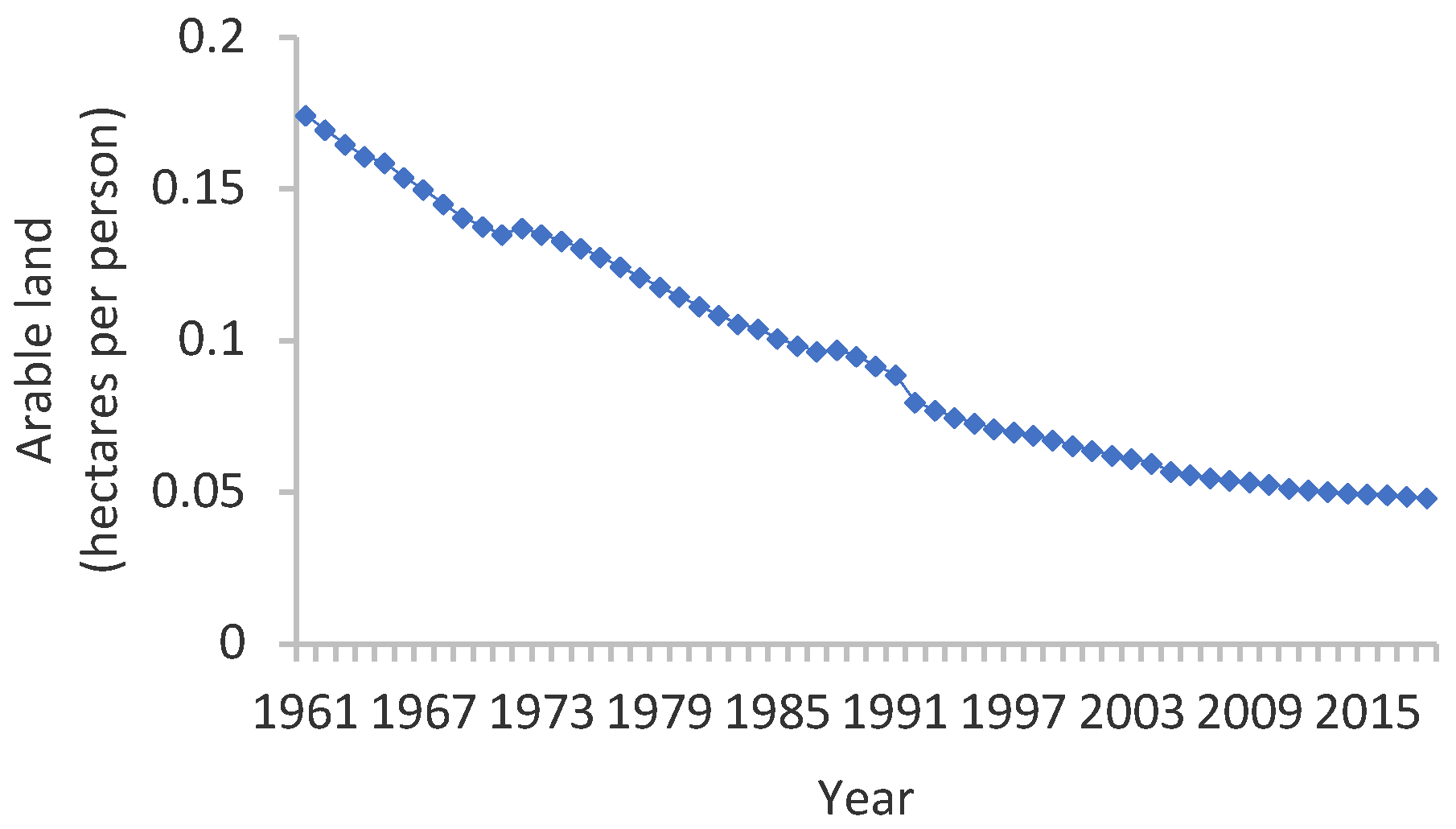
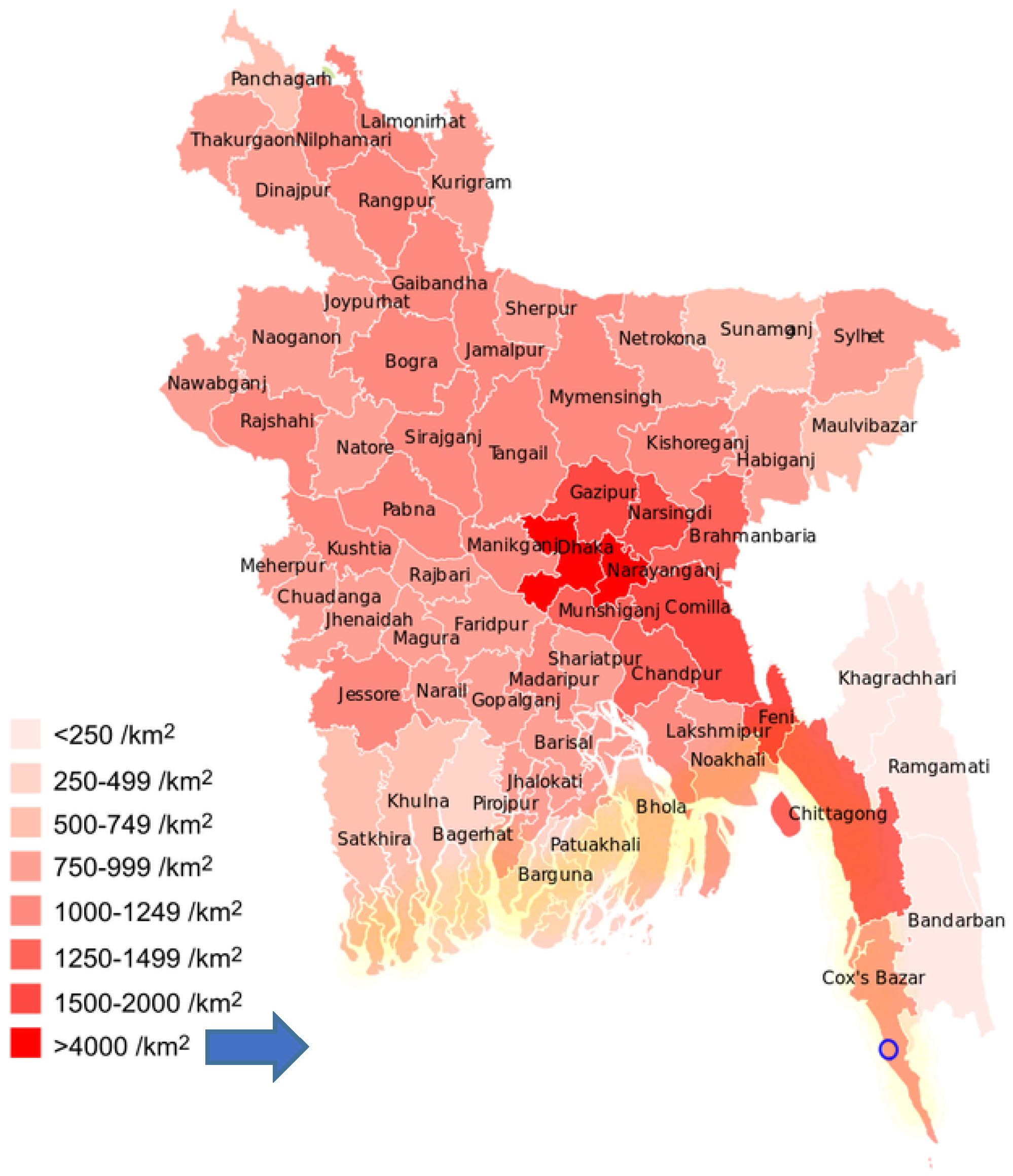
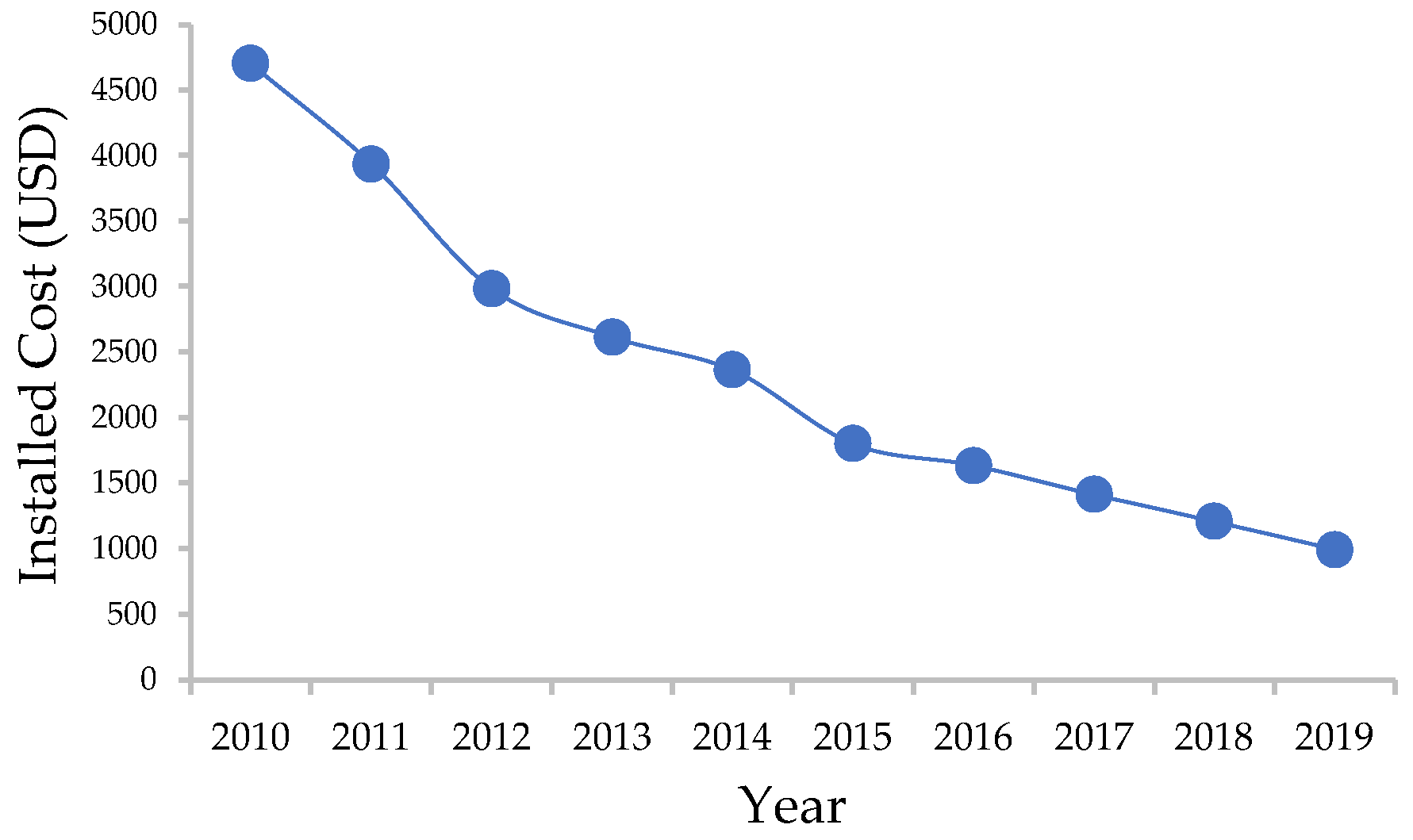
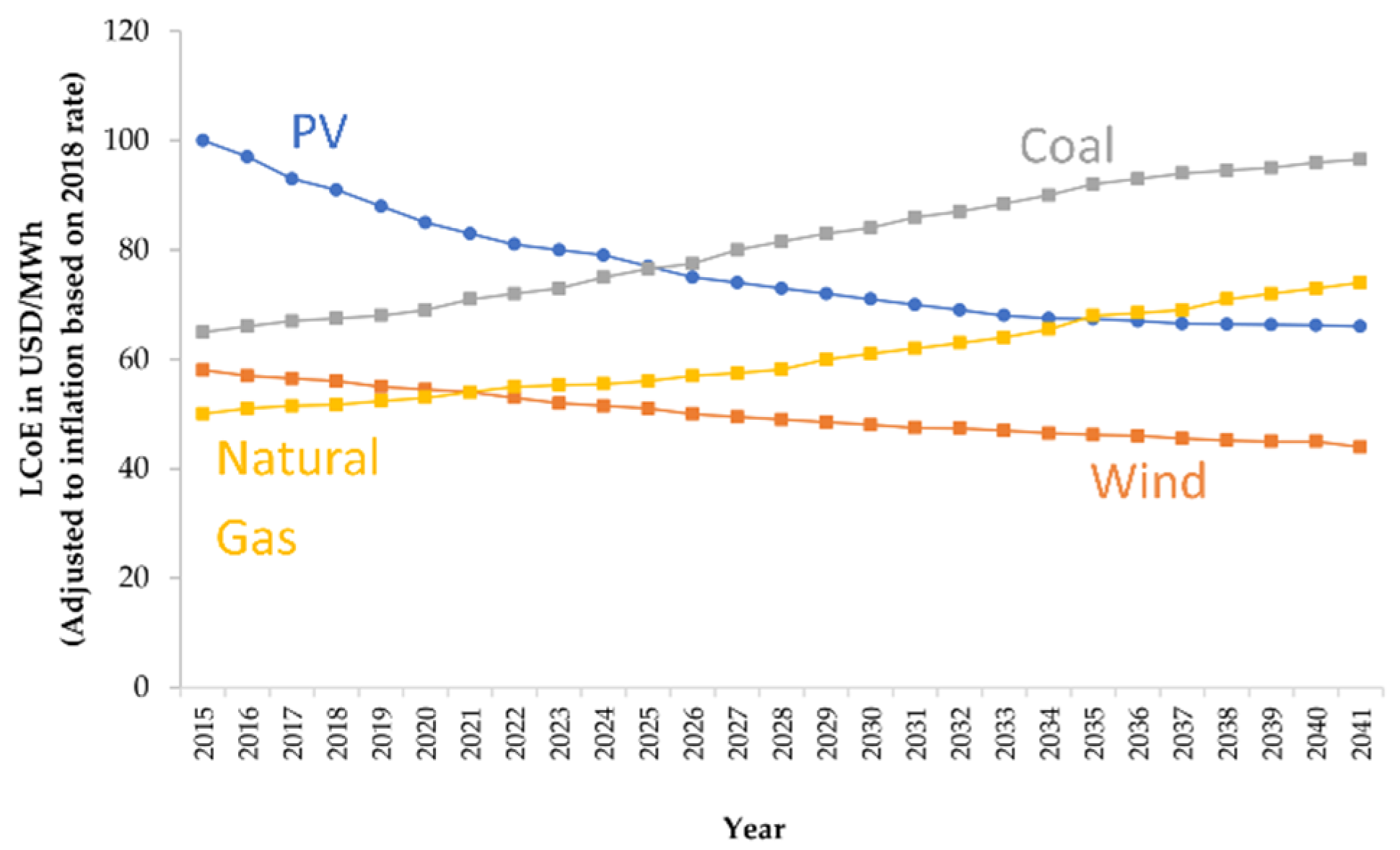
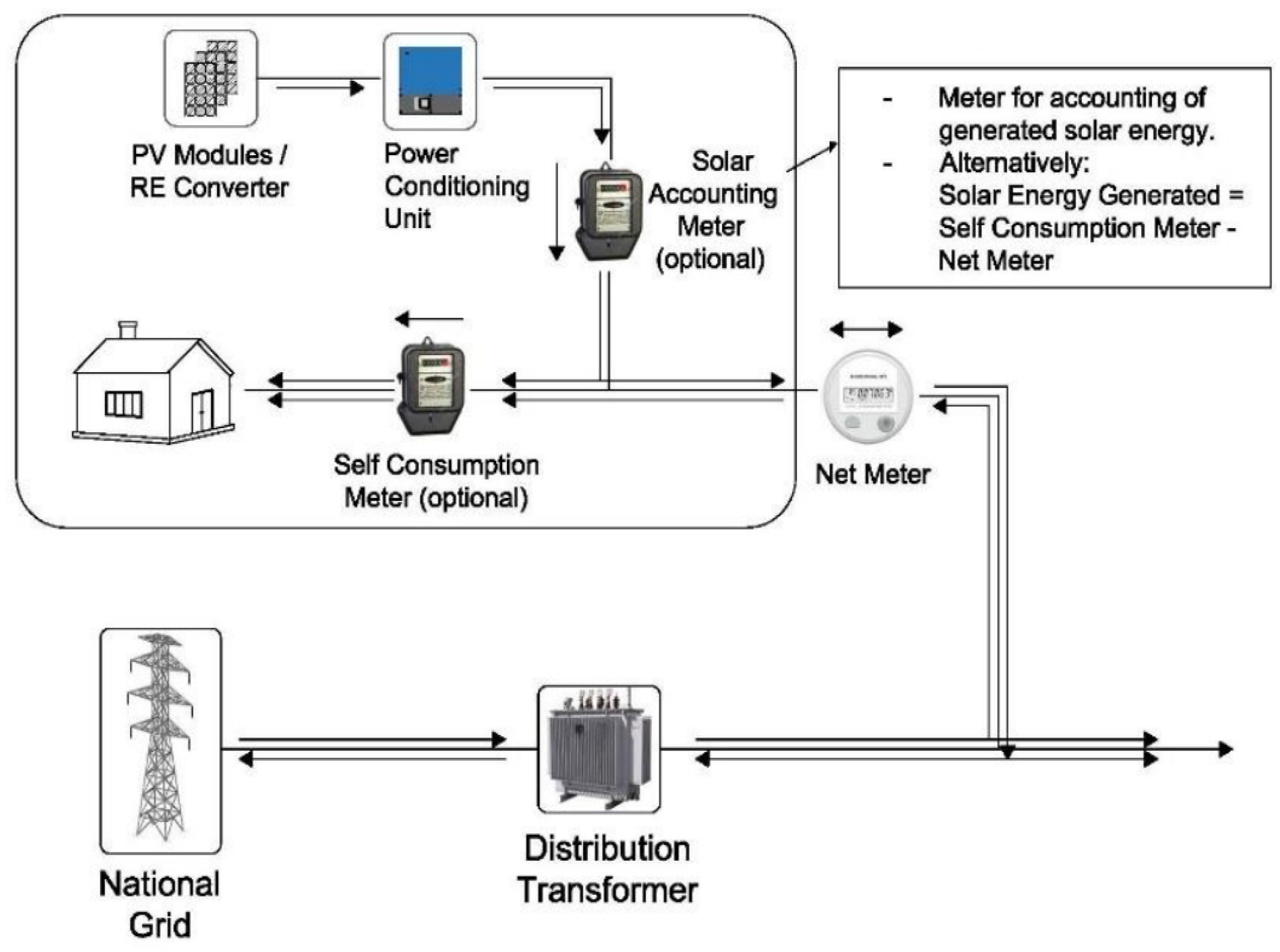

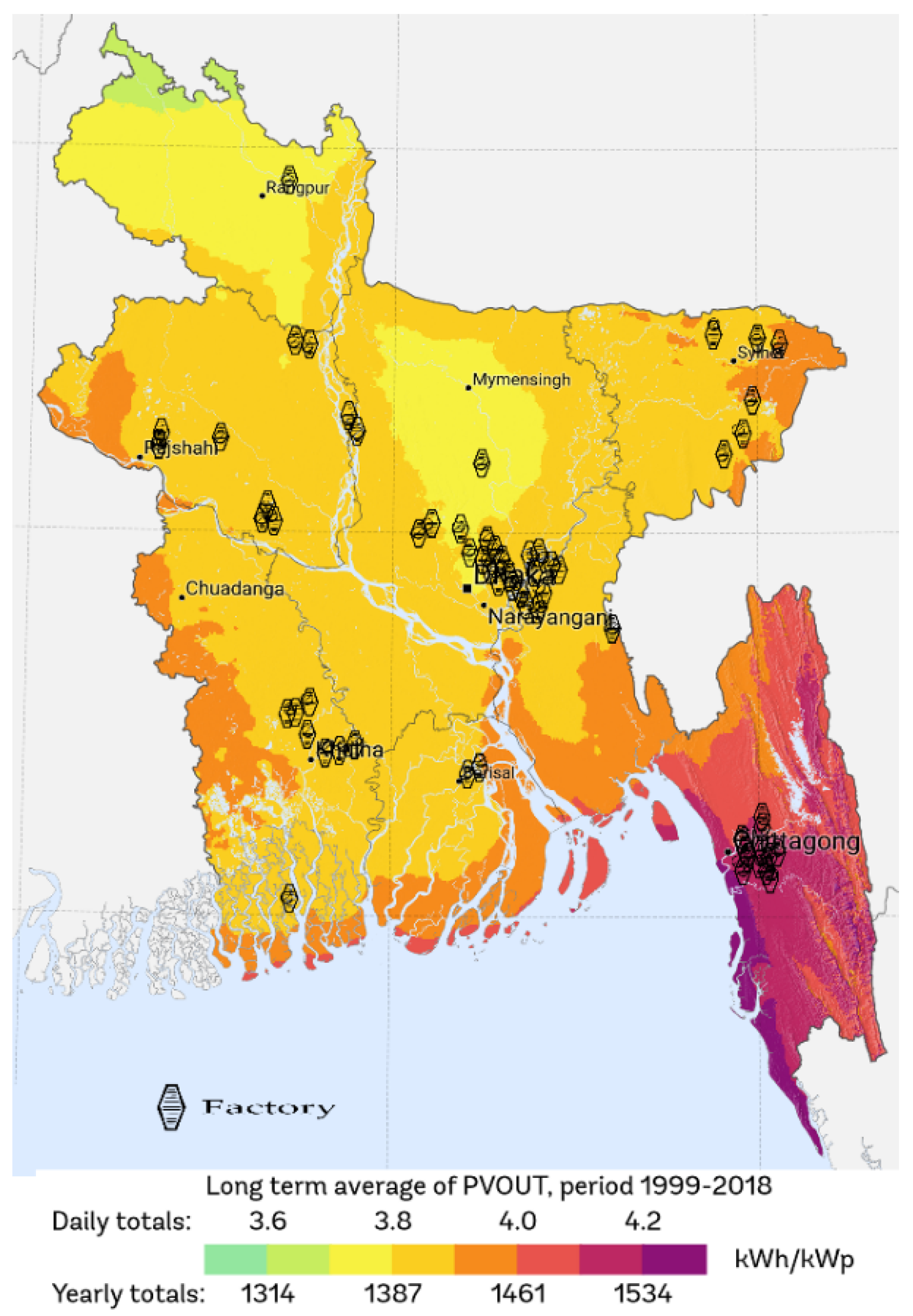

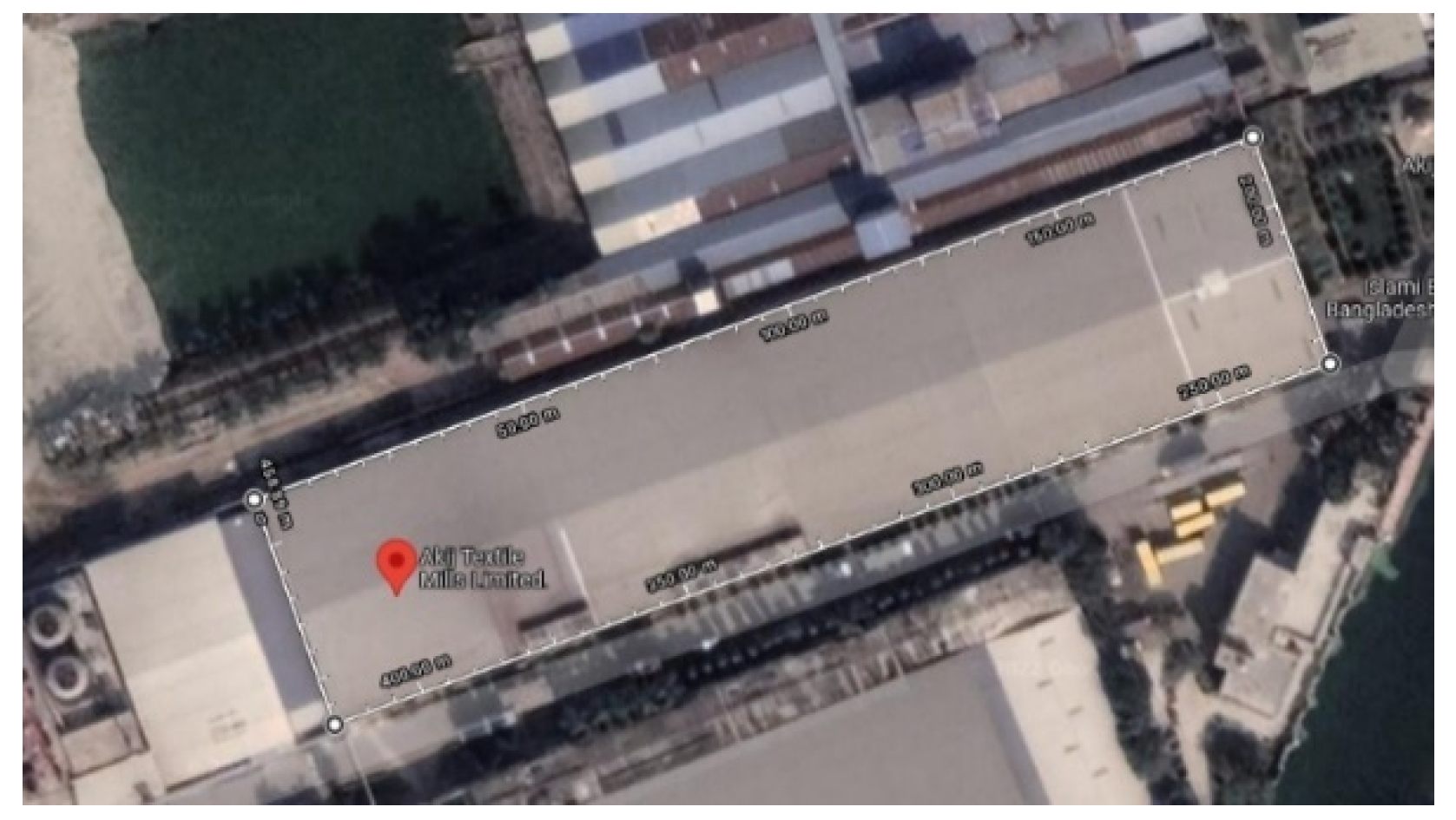
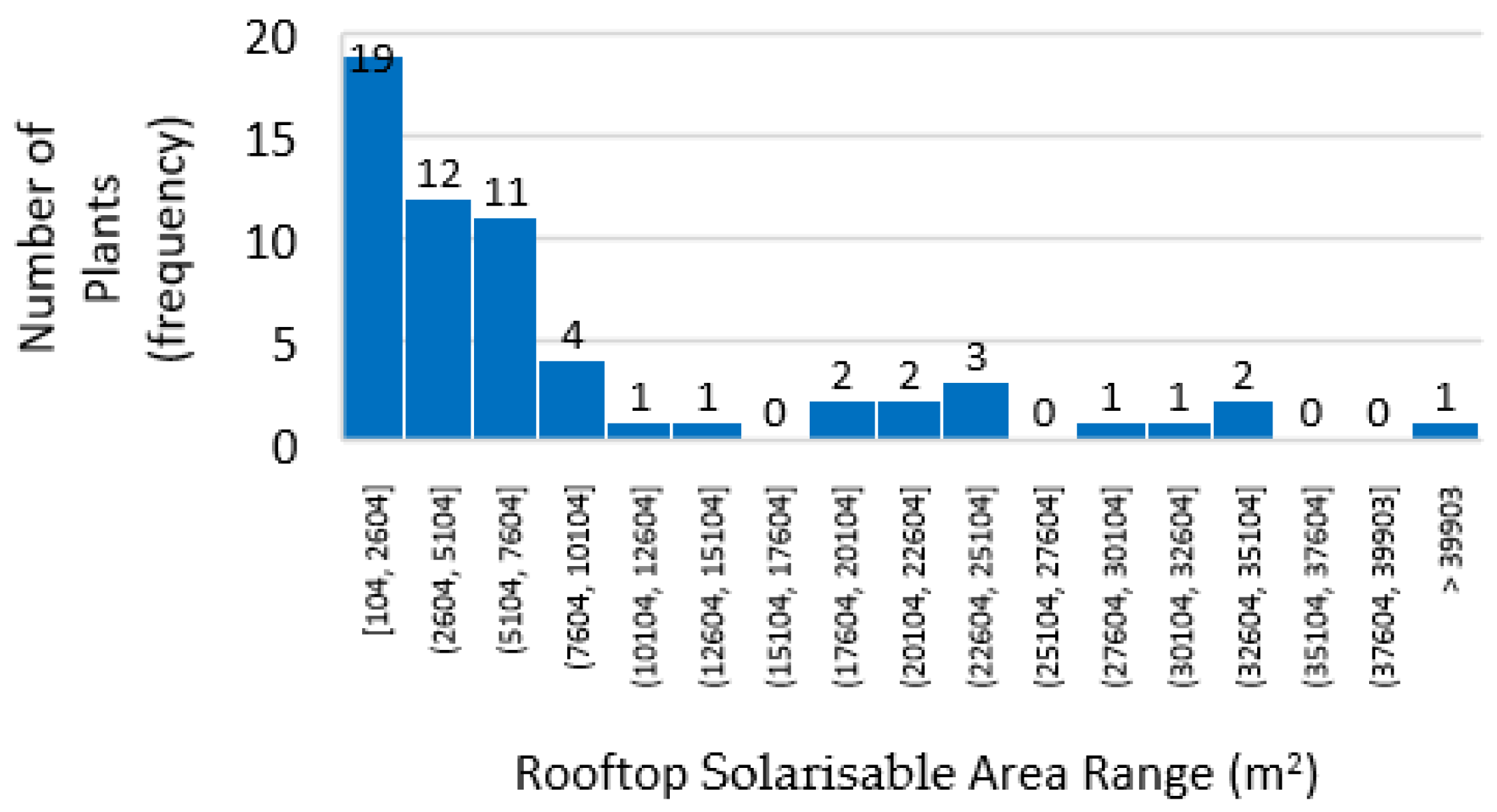
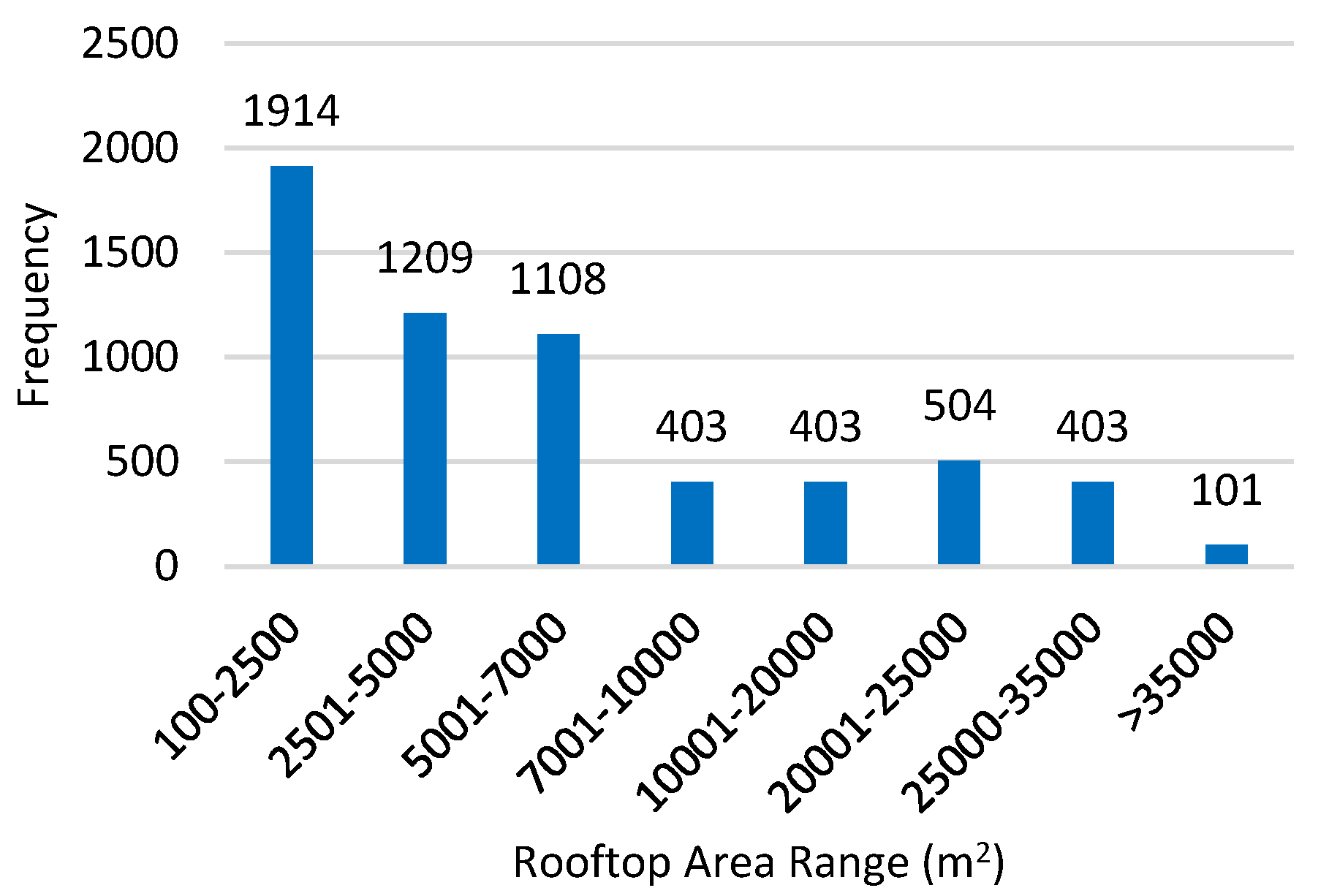
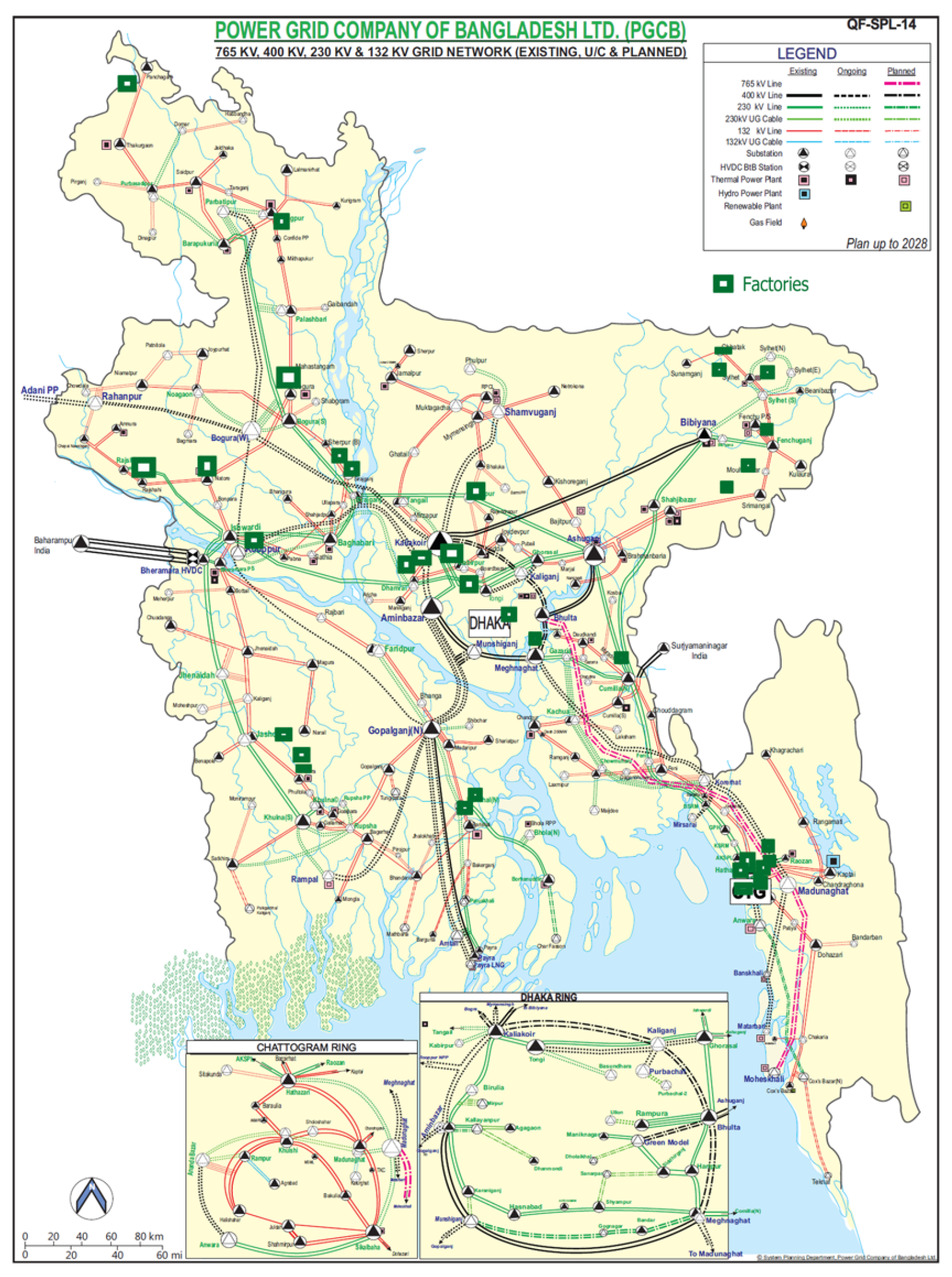
| Factory Name | Rooftop Area (m2) | Percentage of Solarisable Areas | Solarisable Area(m2) | Type | Long–Lat |
|---|---|---|---|---|---|
| ACI Foods, Sirajganj, Bangladesh | 115 | 90 | 104 | Flat | 24.45, 89.68 |
| Gunjan Metal Works, Bogra, Bangladesh | 960 | 60 | 576 | Zigzag gabled | 24.87, 89.36 |
| MEP Energy Saving Lamps, Barisal, Bangladesh | 1521 | 70 | 1065 | Flat, slightly gabled | 22.70, 90.37 |
| Youngone Hitech Sportswear Ltd., Baipayl, Bangladesh | 1733 | 70 | 1213 | Flat but gabled | 23.96, 90.27 |
Publisher’s Note: MDPI stays neutral with regard to jurisdictional claims in published maps and institutional affiliations. |
© 2022 by the authors. Licensee MDPI, Basel, Switzerland. This article is an open access article distributed under the terms and conditions of the Creative Commons Attribution (CC BY) license (https://creativecommons.org/licenses/by/4.0/).
Share and Cite
Talut, M.; Bahaj, A.S.; James, P. Solar Power Potential from Industrial Buildings and Impact on Electricity Supply in Bangladesh. Energies 2022, 15, 4037. https://doi.org/10.3390/en15114037
Talut M, Bahaj AS, James P. Solar Power Potential from Industrial Buildings and Impact on Electricity Supply in Bangladesh. Energies. 2022; 15(11):4037. https://doi.org/10.3390/en15114037
Chicago/Turabian StyleTalut, Muhammad, AbuBakr S. Bahaj, and Patrick James. 2022. "Solar Power Potential from Industrial Buildings and Impact on Electricity Supply in Bangladesh" Energies 15, no. 11: 4037. https://doi.org/10.3390/en15114037
APA StyleTalut, M., Bahaj, A. S., & James, P. (2022). Solar Power Potential from Industrial Buildings and Impact on Electricity Supply in Bangladesh. Energies, 15(11), 4037. https://doi.org/10.3390/en15114037







